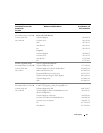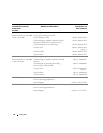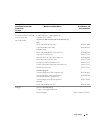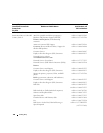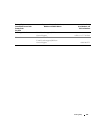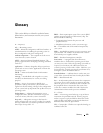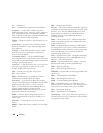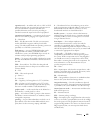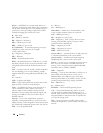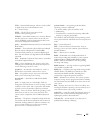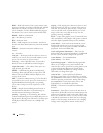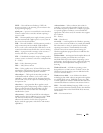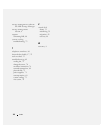
Glossary 107
NMI — Nonmaskable interrupt. A device sends an NMI
to signal the processor about hardware errors.
ns — Nanosecond(s).
NTFS — The NT File System option in the
Windows 2000 operating system.
NVRAM — Nonvolatile random-access memory. Memory
that does not lose its contents when you turn off your
system. NVRAM is used for maintaining the date, time,
and system configuration information.
parity — Redundant information that is associated with a
block of data.
partition — You can divide a physical disk into multiple
physical sections called partitions with the fdisk
command. Each partition can contain multiple logical
disks. You must format each logical disk with the format
command.
PCI — Peripheral Component Interconnect. A standard
for local-bus implementation.
PDU — Power distribution unit. A power source with
multiple power outlets that provides electrical power to
servers and storage systems in a rack.
peripheral — An internal or external device, such as a
diskette drive or keyboard, connected to a system.
PGA — Pin grid array. A type of processor socket that
allows you to remove the processor chip.
physical disk — A hard drive installed in the RAID
enclosure.
pixel — A single point on a video display. Pixels are
arranged in rows and columns to create an image. A video
resolution, such as 640 x 480, is expressed as the number
of pixels across by the number of pixels up and down.
POST — Power-on self-test. Before the operating system
loads when you turn on your system, the POST tests
various system components such as RAM and physical
disks.
processor — The primary computational chip inside the
system that controls the interpretation and execution of
arithmetic and logic functions. Software written for one
processor must usually be revised to run on another
processor. CPU is a synonym for processor.
protected mode — An operating mode that allows
operating systems to implement:
• A memory address space of 16 MB to 4 GB
• Multitasking
• Virtual memory, a method for increasing addressable
memory by using the physical disk
The Windows 2000 and UNIX
®
32-bit operating systems
run in protected mode. MS-DOS cannot run in protected
mode.
PS/2 — Personal System/2.
PXE — Preboot eXecution Environment. A way of
booting a system via a LAN (without a physical disk or
bootable diskette).
RAC — Remote access controller.
RAID — Redundant array of independent disks. A
method of providing data redundancy. Some common
implementations of RAID include RAID 0, RAID 1,
RAID 5, RAID 10, and RAID 50. See also guarding,
mirroring, and striping.
RAID enclosure — A storage enclosure supporting RAID
via a modular controller unit.
RAID array — Collection of storage disks managed under
a RAID solution. The RAID array includes any disks
attached to the RAID controller, including those
contained in a supported expansion enclosure.
RAM — Random-access memory. The system’s primary
temporary storage area for program instructions and data.
Any information stored in RAM is lost when you turn off
your system.
RAS — Remote Access Service. This service allows users
running the Windows operating system to remotely access
a network from their system using a modem.
readme file — A text file, usually shipped with software or
hardware, that contains information supplementing or
updating the product’s documentation.
read-only file — A read-only file is one that you are
prohibited from editing or deleting.



